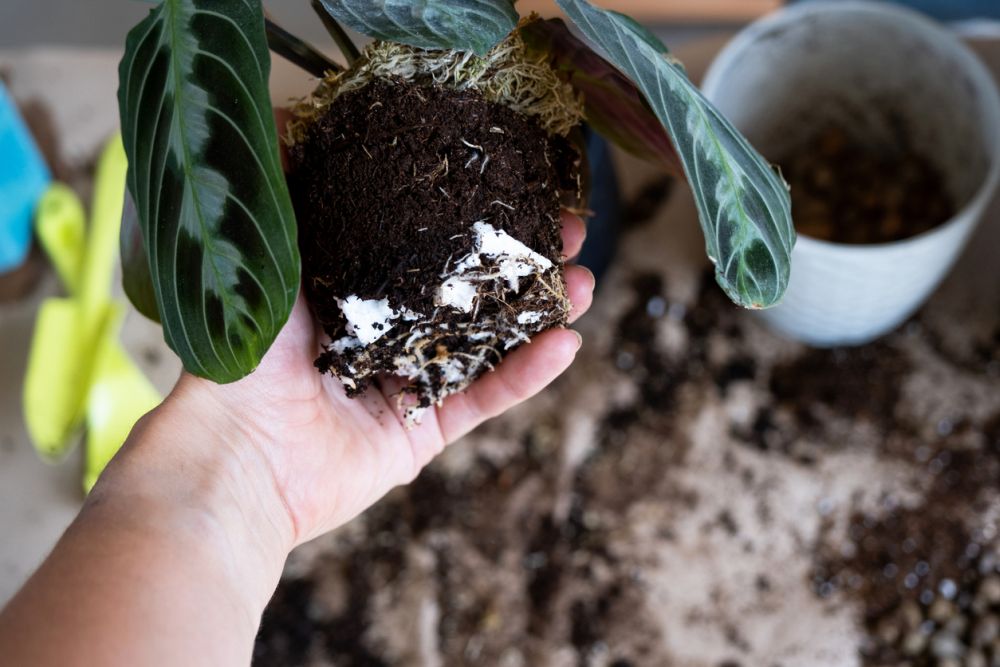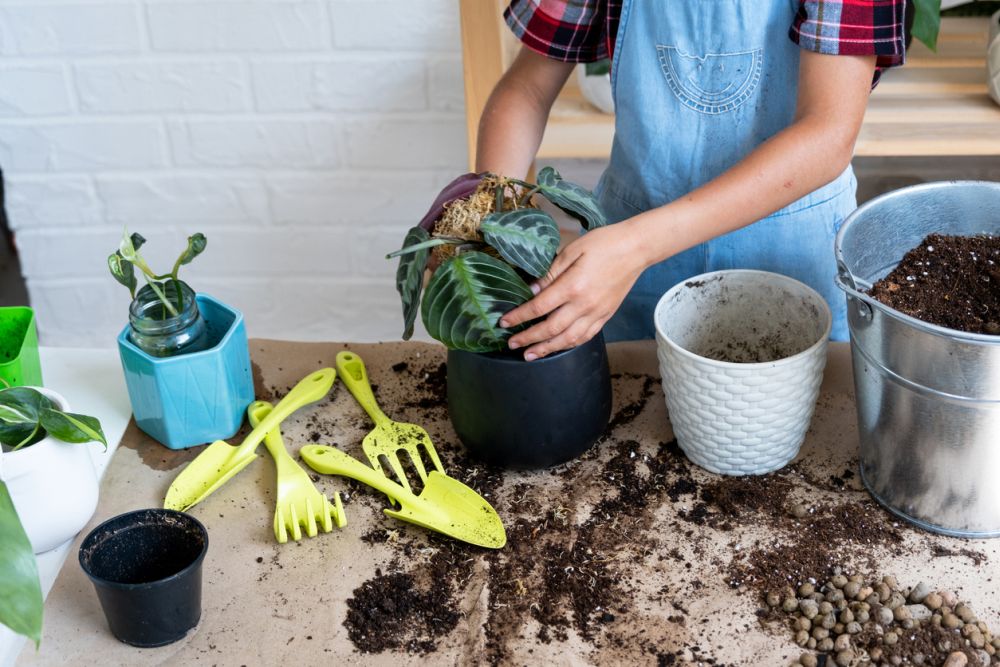How to Repot a Prayer Plant and Care for Your Maranta Leuconeura
Repotting a prayer plant (Maranta leuconeura) is essential for keeping it healthy and looking its best. Read our guide to learn how to transplant your prayer plant from one pot to another.
Prayer plants are popular due to their unique ability to open and fold their leaves following a circadian rhythm. The day-night cycle is easily disturbed by improper growing conditions, so it’s essential to learn the proper repotting techniques for Maranta leuconeura.
This guide describes the supplies and step-by-step instructions for repotting a prayer plant. It also lists the most common signs that a prayer plant needs repotting, tips and tricks for minimizing the effects of transplant shock, and more helpful information.
Why should I repot a prayer plant?
Here are the main reasons for repotting your Maranta leuconeura:
- Top heavy: Prayer plants continue growing throughout their lives, so they will eventually outgrow their pots. A sign that your prayer plant needs a larger container is when it becomes top-heavy and tips easily.
- Overgrown roots: The prayer plant’s root system never stops growing, so it will keep needing pot space. Maranta leuconeura will eventually become root-bound; the roots are so tightly packed around themselves, and the plant has difficulty absorbing water and nutrients.
- Slow growth: Having trouble absorbing water and nutrients translates into impeded or stopped growth. In this case, it’s time to relocate the prayer plant to a new home larger than the current one.
- Your prayer plant looks sickly: Signs of a root-bound prayer plant include yellow and droopy leaves and brown spotting.
- Deformed or cracked pot: The overgrown root system of a prayer plant may deform the pot that houses it, causing it to crack or break.
- Depleted soil: A prayer plant will absorb all potting soil nutrients sooner or later, no matter what. Fertilizing won’t solve the problem, so you must repot the Maranta leuconeura.
- Salt-like mineral deposits: Overfertilization using synthetic fertilizers causes salt-like mineral deposits to build up in the soil, making it challenging for the prayer plant to soak up water and nutrients. In this case, you must discard the old potting mix and use a fresh one.
- Soil doesn’t retain moisture: Outgrown roots take up more space than soil, causing water to pass through the drainage holes without getting absorbed by the potting mix.
- Soil needs constant watering: A prayer plant that demands more watering (more than 2-4 weeks) indicates that the soil cannot retain moisture anymore due to overgrown roots.
Supplies for repotting a prayer plant
- A new pot one or two sizes bigger than the current one, with at least one drainage hole. Since prayer plants have a shallow root system, use a wide pot; a deep one won’t help.
- Porous material (optional) if the new pot doesn’t have drainage holes. Examples are pebbles, terracotta pieces, and charcoal.
- Gardening shears to cut away any damaged, sick, or dead roots.
- A trowel to help dislodge a stubborn prayer plant from its current container.
- Potting mix. Prayer plants prefer a loamy potting mix with great drainage. Make your own potting mix using 50% peat moss, 25% sand, and 25% loam.
- Tarp or newspapers to protect the work area from dirt.
How do I repot a prayer plant?
Check out the complete step-by-step instructions for transplanting a prayer plant into a new pot:
- Choose the right season: Early spring is the best time to repot a prayer plant. Urgent repotting may be performed in summer or fall, although the Maranta leuconeura will require better care during the transplant shock period. Avoid repotting the prayer plant in late autumn or winter since it won’t survive.
- Water the prayer plant in advance: Thoroughly water the prayer plant about 2-3 days before repotting it to moisten and loosen the soil.
- Spread the tarp: Choose a work area for repotting the prayer plant and lay down a tarp or newspaper.
- Remove the prayer plant from its pot: Grab the prayer plant by the stem, close to its base, and gently pull it with your other hand. If it’s housed in a plastic pot, gently squeeze the container to help the plant pop out. Use your fingers to untangle any roots from the drainage holes.
- Tend to the roots: Carefully untangle the roots wrapped around each other or the pot and remove any soil clumps still hanging.
- Check the roots: Closely examine the roots to cut away any sick, damaged, or dead ones. Unhealthy roots are brown, black, or soggy, while healthy roots are light-colored and firm.
- Prepare the new pot: Line the pot bottom with porous material if it doesn’t have a drainage hole. Next, fill the pot with 4-5 in (10-13 cm) of potting mix.
- Add the prayer plant to its new pot: Place the plant in its new container so the rootball sits about 1 in (2.5 cm) below the pot’s rim. While keeping the prayer plant vertically, fill the pot with the remaining soil mix. Avoid burying the plant’s crown in the soil mixture since this will lead to rotting stems. Firm the soil around the roots so that it holds securely in place. If any soil gets on the leaves, clean them with a damp towel.
- Water the plant: The soil needs to be moist, so give your prayer plant plenty of water. Stop when water trickles through the drainage hole.
Tips for managing prayer plant transplant shock
Prayer plants are susceptible to transplant shock when their roots are damaged during repotting. During transplant shock, the Maranta leuconeura is busy tending its roots and faces greater exposure to environmental issues, pests, and diseases. Signs of transplant shock include yellow, wilting, or curled-up leaves.
To avoid transplant shock, it’s best to keep the roots intact and moist when repotting your corn plant. Move quickly to prevent the root ball from staying exposed to oxygen for too long, and ensure the potting mix has the same temperature as the old one (it should be mild).
When facing a prayer plant undergoing transplant shock, it’s best to wait until it’s over. Check out the following tips and tricks for managing transplant shock and encouraging the prayer plant’s recovery:
- Water consistently: The soil of the prayer plant must always be moist but never soaked. Check that the first 2-3 in (5-8 cm) of soil are dry before watering. Avoid watering the leaves since it will promote fungal growth.
- Avoid direct sunlight: Prayer plants thrive in indirect sunlight but are weak against direct sunlight.
- Fertilize: The Maranta leuconeura requires fertilization every 2 weeks using a water-soluble fertilizer.
- Ideal temperature and humidity: Prayer plants prefer 60-80° F (16-27° C) temperatures and 40-60% humidity.
FAQs
Discover more useful info about prayer plants.
Do prayer plants like big pots?
Yes, prayer plants need bigger pots to keep growing. When repotting your Maranta leuconeura, choose a new container that’s only one size larger than the current one. An oversized pot will stress out the plant.
Do you water the prayer plant after repotting?
Yes, it’s recommended to thoroughly water the prayer plant after repotting it. Stop pouring only when water seeps through the drainage holes. Subsequently, water the Maranta leuconeura only when the 2-3 in (5-8 cm) of topsoil are dry.
Should I cut the brown tips off my prayer plant?
Yes, it’s best to cut the brown tips off your prayer plant as soon as possible. Otherwise, the whole leaves will turn brown and fall off.
Closing thoughts
There’s nothing complicated with transplanting a prayer plant to a new container since it’s the same process as repotting any other plant. On the other hand, the Maranta leuconeura requires special care during transplant shock.


